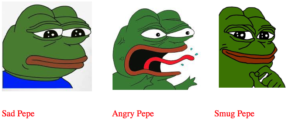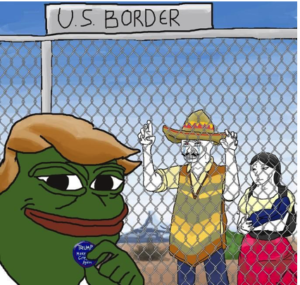The Life and death of Pepe the Frog: How the alt-right transformed the internet’s favourite Meme into a mascot of hate.
Meme: ‘an idea, behaviour or style that spreads from person to person within a culture’. Fast-forward to the Internet age, ‘meme’ has been redefined. Still claiming to replicate and connect behaviours and styles between persons, ‘meme’s’ have become an important communicative skill and aspect of online digital identity.
In recent years, however, certain memes have overstretched this mark, articulating more than just identity politics, reaching instead into virgin territory within the mainstream political sphere. Meet ‘Pepe the frog’.

Pepe’s polymorphic appearance has allowed his digital identity to be hijacked by stealth linking of his image to the alt-right and their agenda. Through using a system of encoded, ‘ironic’ and offensive Pepe memes to articulate their politics, hiding their hateful rhetoric in plain sight.
Pepe, the brainchild of Matt Furie, first appeared on Reddit and 4chan in 2008. Appealing initially to fans of scatological and stoner humour, Pepe’s Internet fame began with a cheerful grin and fun catchphrase: ‘Feels good, man’. His changeable appearance saw fans alter Pepe’s smile, making him a vehicle for displaying a variety of emotions, like ‘Sad Pepe’, ‘Angry Pepe’ and ‘Smug Pepe’.

Pepe, encoded with different emotions made him relatable, and a viral sensation. Soon ‘Rare Pepe’s’ emerged, and with their ample presence, Pepe’s image was easily hijacked. It was only a matter of time before the alt-right appropriated him; as Mike Godwin correctly prophesied in the 1990s “as an online discussion grows longer, the probability of a comparison involving the Nazis or Hitler approaches.”
Suddenly the ‘rare Pepe’s’ characterising the alt-rights online visual presence weren’t so rare, becoming some of the most common forms of Pepe’s. On the same messaging boards where Pepe originally went viral, the alt-right presence grew, reaching a pinnacle in 2016 with Trump’s presidential campaign. The 4chan “politically incorrect” board became a cesspool for alt-right culture, where “Trump fans could be themselves in all their glory without apology”. Here the alt-right happily capitalised on Trumps anti-immigration and anti-establishment campaign, riding his coat-tails and thrusting their own agenda into the political mainstream.
The alt-right achieved this by monopolising popular culture and exploiting the Internet’s love of memes. Further, their connection to Trump, who is associated with popular culture as an ex-reality TV star, led one alt-righter to describe him as “meme-able”, stating that he has helped alt-right ideas gain “much greater influence.” Trumps ‘meme-ability’ led to the creation of Trump Pepe, seemingly overnight the symbiotic relationship between the two saw Pepe elected as the unofficial mascot of Trump’s online presidential campaign.

Over time the alt-right agenda invaded ‘normie’ online communities, popularised through the appropriation of Pepe, despite their overtly offensive agenda. The appropriation of the original Pepe, who had enjoyed celebrity status within the meme community meant the alt-right could integrate their politics with images of Pepe, spreading their message successfully. Hiding behind the argument that Pepe was always ‘light-hearted’ in nature, they used his image as a shield, all the while inciting hateful rhetoric (see figure 4 below).

Specifically, the alt-right used the humorous image and ambiguity of Pepe to wrong-foot their opponents, spreading their controversial narrative of Islamophobia, misogyny, and white supremacy throughout Internet culture. It is their impressive use of ‘irony’ as Dr. Alice Marwick noted, that “allows [the alt-right] to disclaim a real commitment to far-right ideas while still espousing them.”
Using irony in this way is an incredibly effective position. We, the opponents of the alt-right are told that if we fall for their irony, we are hysterical, sensitive, liberals, unable to detect a ‘joke’. We are meant to feel embarrassed at our inability to detect satire. As a consequence, we avoid the alt-right, neither attacking nor criticising them, leaving them untouched. The alt-right message is retained and their politically insensitive Pepe’s continue circulating the internet, protected under their claim of ‘irony’. Every repetition of far-right ideas contributes to the environment in which they are normalised; which ultimately, is their aim.
This strategy, known as the ‘wink-wink-wink’, acts as a nod to alt-right spectators who hold the ability to decode the message behind the irony. As Stuart hall in his groundbreaking work notes, ‘a message can only be received at a particular stage if it is recognizable or appropriate—though there is space for a message to be used or understood at least somewhat against the grain’. Hall claims, our ability to decode comes from ‘an individual’s cultural background, economic standing, and personal experiences’. Those with the right decoding tools are familiar with the alt-right communities use of these tactics, and thus able to decode the preferred reading within the ‘dominant-hegemonic position’ behind the irony. The alt-right communicate through ‘perfectly transparent communication’, in comparison to those from outside the alt-right community who experience ‘systematically distorted communication’. In this way, for example, they would simply see figure 3 as a funny picture of Trump with a funny frog, unaware of the alt-right connection. Unbeknownst to them by sharing this image they are actually circulating alt-right propaganda.
Interestingly, some alt-right spectators observe this tactic by sharing memes that overtly present this manipulative action. For example, figure 5, where Trump is shown ‘disavowing the alt-right’ followed by ‘winking’, whereupon we see an image of ‘Smug Pepe’ declaring he has ‘understood’ that Trump’s statement was ironic, and that the two are really in cahoots.

The connotations of a wink make this reading obvious to those with knowledge of Pepe’s appropriation from the alt-right, and to those from outside the alt-right community. This development where the alt-right overtly expose their agenda is indicative of the success the alt-right have experienced in gaining acceptance within popular Internet culture.
To reiterate, through the hijacking of Pepe, the alt-right have successfully articulated their hateful politics, bringing it directly into the political climate of America, and to the attention of spectators. In his own statement, Furie stated how ‘It’s completely insane… that racists and anti-Semites are using a once peaceful frog-dude …as an icon of hate’. Pepe’s transformation from a harmless, empathic frog, to a politically motivated mascot of hate, was complete. Despite campaigns to #savepepe, the Anti-Defamation League identified Pepe as a ‘hate symbol’ because of his racist connotations. Lastly, in a final attempt to #savepepe from further life as the alt-right mascot, Furie officially killed him on 6th may 2017. However, as one commentator aptly put it that just like Elvis, “Pepe is going to live on regardless of whether we put him in a casket in a cartoon’.
